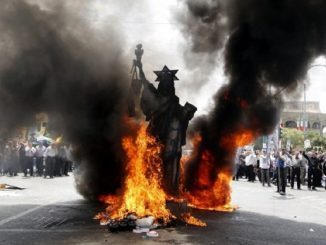
How inflammatory headlines, unnamed sources and decades of misinformation in the US media over Iran play their part.
Hyped-up headlines, “anonymous” sources and unspecified threats – Iran is back in the news in the United States.
It wouldn’t be the first time the US media, wittingly or unwittingly, have made the case for war on the basis of vague, anonymously sourced intelligence. In 2003, it was Iraq. In 2019, it’s Iran. Much of American news reporting on US-Iran relations glosses over President Donald Trump‘s role, how his policies have led to this standoff.
There’s even less space given to reflect on the history of the US aggression against Iran. Which is not to say the Islamic Republic, ruled by authoritarians and involved in wars in Syria and Yemen, is an innocent player. However, inflammatory headlines, unnamed sources and decades of misinformation in the US media over Iran – don’t help.
“All of a sudden, you have a news headline that takes over the world which comes from rather dubious and questionable sourcing,” explains Ali Vaez, the director of Iran Project at International Crisis Group. “But by the time that people start asking questions, it’s already too late because the narrative has been framed.”
The 2003 Iraq war is considered the greatest collective failure in the history of American journalism. And it’s far too soon to see those kinds of practices in use, once again.
“The US media was not critical at all of the George W Bush administration in the lead-up to the Iraq war,” points out Narges Bajoghli, an assistant professor of Middle East Studies at Johns Hopkins University. “And in this instance, we are seeing the same sorts of attributions begin again when in US media they’re talking a lot about threats from Iran and yet they’re not providing much intel about that.”
In the news business, context matters. And it’s largely missing in the US-Iran coverage.
For most Americans, this conflict goes back to the 1979 Islamic revolution and the subsequent hostage-taking of 52 Americans in Tehran that were held captive in their embassy for 444 days.
That is what led to the 1979 hostage crisis that Iranians remember.
In 1953, the US-aided coup brought down the government of Prime Minister Mohammad Mossadegh and reinstalled the Shah of Iran, who would rule his people for a quarter century.
But there is even more to US-Iran history. Such as the role the US played in the Iran-Iraq war, in the 1980s, when the Reagan administration helped Saddam Hussein’s forces and his army used chemical weapons. At least 100,000 Iranians were casualties of that.
Despite that troubling backstory, in 2015, Iran came to an agreement with the US, the European Union and five other countries in which it agreed to limit its national nuclear program in exchange for the lifting of economic sanctions.
The Iranians stuck to their end of the deal. The Trump administration did not, pulling out of the pact last year, unilaterally.
But US news outlets, that are usually not shy with their criticism of President Trump, provide him with much more leeway on foreign policy than on domestic issues.
“Iran’s policies in the region are often described as “malign”, “nefarious”, “destabilizing” as if everybody else’s actions in the region are benign and stabilizing,” says Vaez. “I think this kind of demonizing and portraying Iran as the source of all evil in the region is by definition a hype and by definition results in misguided policies that could produce another tragedy like the Iraq war.”
Contributors
Negar Mortazavi – Consultant editor, The Independent
Ali Vaez – Iran Project director, International Crisis Group
Narges Bajoghli – Middle East Studies, Johns Hopkins University
Monalisa Freiha – Associate editor, An-Nahar newspaper



